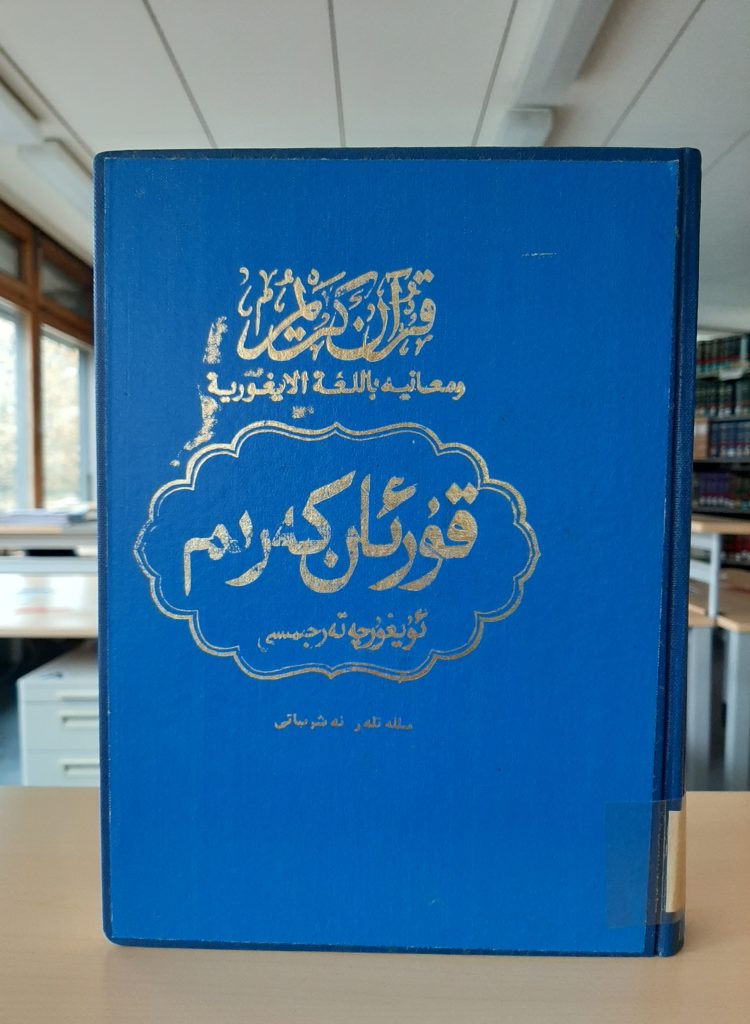The history of Qur’an interpretation in Eastern Turkic areas has its roots in the medieval era while Qur’an translations, in the modern sense of independent books containing the translated text of the Qur’an, have appeared only recently. The few twentieth-century Qur’an translations that have been published in the area were more like tafsīrs than translations. However, in the mid-1980s a new, rather innovative translation appeared, written in the Uyghur Perso-Arabic script, in the Uyghur language (Uyghurche tili). Nowadays, it is spoken by at least fifteen million people in the west of China (Xinjiang), the east of Kazakhstan, and beyond. The early 1980s were a time of changing religious politics in Xinjiang, during which the Muslim population there experienced a kind of religious and national revival. This was strongly connected attempts to ‘officialize’ Islam within a state-controlled framework.
Thus, in 1983, the Xinjiang Islamic Institute opened its doors to students, and in 1986 the rector of the Institute, Sheikh Muhammad Salih published his own translation of the Qur’an into the Uyghur language. This was published in quite a large print run by the Beijing-based Mínzú Chūbănshè (‘The Publishing House of Minority Nationalities’). As soon as 1992, a second edition was printed by the King Fahd Qur’an Printing Complex in Medina (after a special review), and a third edition was produced in 2016 in Ankara, Turkey, by the Turkish Directorate of Religious Affairs. All three published editions of the Qur’an were prepared with the direct participation of the translator. The translator, Sheikh Muhammad Saleh (1939–2018), came from a family with a well-established scholarly lineage.

An active member of the local Muslim community, in the late 1970s Sheikh Muhammad Saleh became one of the most well-known representatives of the Uyghur Muslims. During his travels to the Middle East he met many religious scholars and discussed the idea of a Uyghur Qur’an translation with late Mufti of Saudi Arabia, ʿAbd al-Azīz ibn Bāz. In addition to his Qur’an translation, Sheikh Muhammad Salih also published a number of works on Arabic literature and history, as well as a translation of the Sunnah corpus (called ‘Riyāḍ al-ṣāliḥīn’).
According to reports, Sheikh Muhammad Salih died in January 2018, after being imprisoned by the Chinese authorities. The first edition of the translation opens with an introduction by the translator, which is preserved verbatim in the later King Fahd Qur’an Printing Complex translation. In it, the author discusses the idea of Qur’anic inimitability, but goes on to outline the need for Uyghur-speaking Muslims to apprehend the original meanings of the Qur’an in their native language. He also talks about the possibility of explaining the basics of the Qur’an’s religious vocabulary, but regrets that there are limited options to convey the Qur’an’s literary style in another language. At the end of both the original and KFQPC editions, a list of tafsīrs consulted by Sheikh Muhammad Salih is provided. This lists 38 sources, from the early (and reconstructed) ‘Tafsīr Ibn ʿAbbās’ to Sayyid Qutb’s twentieth century ‘Fī ẓilāl al-Qurʾān’ (‘In the Shade of the Qur’an’).


Other additions include list of proper names used in the Qur’an, as well as some statements on Sheikh Muhammad Salih’s translation principles, which fully equate translation with tafsīr (and thus frequently use the expression ‘tercüme – tefsīr’). The team who undertook revisions of the initial translation, colleagues from the Xinjiang Islamic Institute, are also acknowledged, which means that the work can be viewed as a kind of officially sanctioned institutional project. When it comes to style, the translation is a direct rendition of the Qur’anic text, with only minor insertions and a few comments in the form of footnotes. The Arabic text of the Qur’an (which is presented alongside the translation) is based on the Arabic textprinted by the Taj Company in Lahore, one of the most popular publishers of the Qur’an and Qur’an-related literature in Pakistan. The translation itself sometimes looks like a literal re-wording, while other verses are translated in an ‘explanatory’ way.
When comparing the original edition to the second 1992 edition produced by the KFQPC, the only obvious change relates to the presentation of the name ‘Allāh’. In the KFQPC edition, this is being written according to Arabic orthography rather than the original Uyghur spelling (with the addition of an alīf after the second lām). As with other translations into Turkic languages, the translation uses regional vernacular to render Islamic religious terms. For example, the phrase ‘ṣalli li-rabbika wa’nḥar’(‘So pray and sacrifice to your Lord’) from Q. 108:2 is translated using the words ‘namāz’ (‘prayer’) and ‘qurbān’ (‘sacrifice’). The word ‘kawthar’ from the previous verse is translated as ‘abundant good’, a good illustration of the way that the translator has opted for a broader meaning in conveying some basic Qur’anic vocabulary. As some reviewers of the translation have noted Sheikh Muhammad Saleh has tried to use domestic wordings to convey notions of space and time in the Qur’an, rather than Persian or Arabic terminology, thereby orienting his work towards the mass readership.

As is typical of Turkic translations, the names of the suras are not translated, but transliterated (according to the reading in Uyghur). The third edition of the translation generally presents the same text as the KFQPC edition. Recently, the text has also become available online in the multi-language resource QuranEnc.com (which encompasses more than 70 complete translations of the Qur’an). Despite the existence of some newer translations into Uyghur (published in 2003 and 2012), the translation by Sheikh Muhammad Saleh can still be regarded as one of the most important and widely read contributions to the study of the Qur’an in the Uyghur language.
Mykhaylo Yakubovych
